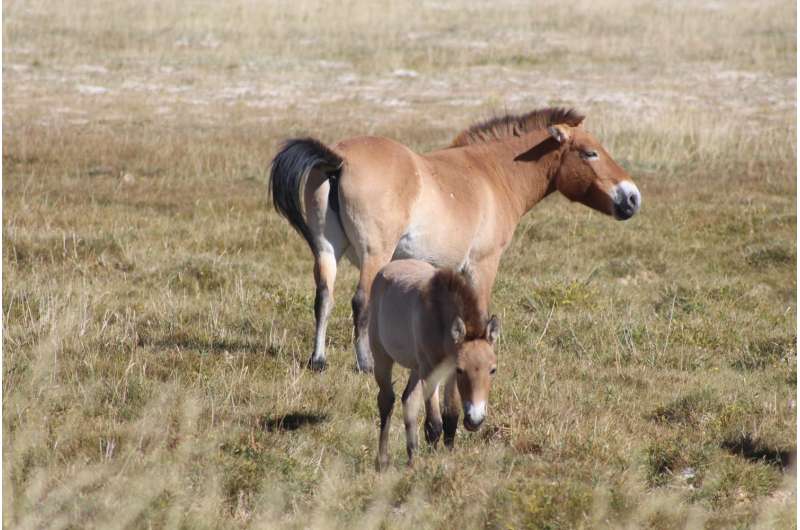Reintroduced Przewalski's horses have a different diet

The Przewalski's horse, also called Takhi or Mongolian wild horse, is the only remaining wild horse species. In 1969, wild horses were officially declared extinct. However, a few animals survived in captivity. In 1992, first captive bred wild horses were returned to the wild.
Petra Kaczensky and Martina Burnik Šturm from the Research Institute of Wildlife Ecology from the University of Veterinary Medicine, Vienna now found out that before their extinction in the wild Przewalski's horses were on a mixed diet. In summer, they only ate grass, in winter also less nutritious bushes. After their reintroduction, the animals only eat high-quality grass throughout the year.
"We explain this dietary shift by an improved human attitude. In the past, humans considered Przewalski's horses as pasture competitors and hunted them as a food source. The nutritious pastures were reserved for domestic sheep and cattle. Thus, access to pastures in winter was difficult for wild horses. Shrubs and bushes were the only alternative," explaines Martina Burnik Šturm, one of the lead authors.
Przewalski's horses are "holy animals" today
Unlike in former times, Przewalski's horses are today worshiped as "holy animals" in the Gobi Desert. They are fully protected and are no longer hunted by humans. "The wild horses can now feed on grass throughout the year because humans allow it", says wildlife biologist and lead author Petra Kaczensky.
Habitat in the Gobi Desert has hardly changed
In the last 120 years, the habitat of the wild horses in Southwest Gobi has hardly changed. The available food resources have remained the same. But the social acceptance of Przewalski's horses has changed.
The situation is different for Asian wild asses or Khulan that also live in the Gobi Desert. Although they are also a protected species, they are less appriciated than wild horses among the people. They are still hunted by humans and chased away from nutritious pastures. They feed on grass only during summer, but in winter mainly on bushes and shrubs like they, as well as the Przewalski's horses, had to in the past.
"In Khulan, we clearly see the influence of humans on the animals' way of life. The attitude towards the animals in society significantly influences their feeding behaviour," so Kaczensky.
Diet has been detected in hair
A common method to understand the animals' ecology and behaviour is to analyse the chemical composition of its hair. This involves the analysis of stable isotopes, which are variants of the same chemical element with different atomic weights,containing the same number of protons, but different number of neutrons. The isotope ratios of hydrogen, oxygen, carbon and nitrogen in a sample provide essential information on the animals' water uptake, nutrition and habitat.
The analysed historic Przewalski´s horse and Khulan hair samples have been provided by the researchers from the Zoological Museums in St. Petersburg and Moscow. "These more than 120-year-old hair samples are as useful and informative as freshly collected ones," explaines Burnik Šturm.
How does the measurement of hair isotopes work?
For the isotope analysis, the tail hair is cut into one centimetre long segments and placed individually in little tin or silver cups before being burnt at high temperature. Isotopes are then measured in the developing gases using mass spectrometry, a method to sort individual atoms by mass.
More information: Petra Kaczensky et al. Stable isotopes reveal diet shift from pre-extinction to reintroduced Przewalski's horses, Scientific Reports (2017). DOI: 10.1038/s41598-017-05329-6
Journal information: Scientific Reports
Provided by University of Veterinary Medicine—Vienna



















